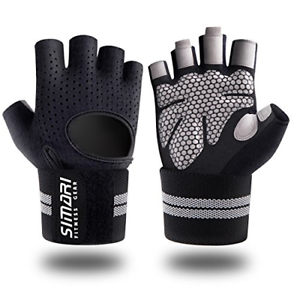Workout gloves, gym gloves or weight lifting gloves, no matter how you name it, are an important part of any gym enthusiasts kit. Unless you’re using a pair of those, you’re exposing yourself to the frequent occurrence of painful blisters, calluses, and the chance of getting a serious injury. Though it’s true that just wearing gloves doesn’t completely eradicate the chance of getting those blisters and calluses – here you must notify the word “completely”. A pair of gloves definitely help to lower the chance of getting calluses and blisters and it reduces the number and frequency of the same. Moreover, preventing blisters and calluses is not the only goal when somebody wears gym gloves – rather preventing accidental slippage of heavyweights while lifting is the main reason.
How to recognize proper weight lifting gloves?
These gloves can be made of various materials like lycra, leather, polyester, neoprene, spandex, etc. – material wise these are no different than other normal gloves. However, weight lifting gloves have a distinct feature – it mainly covers the palm and wrist area and doesn’t cover the full length of fingers. Hence, it’s easy to differentiate weight lifting or gym gloves from other ones, there’s almost no that you’ll mistake one for another.
What’s the reason behind not covering the full length of fingers?
It’s easy to understand for those who lift the weight. In short, the fingers are not covered so that a lifter can grip the weight with his/her fingers – without proper technique of gripping, weight lifting can be a dangerous resulting injury.
What are the different parts of a pair of weight lifting gloves?
Basically, a glove made of combining 4 different parts, such as –
Palm: This part of a glove is padded with various material like spandex, silicone, neoprene or microfiber – to aid cushioning and gripping on the weight or gym bars.

Back of hand: It’s the back side of the glove.
Finger: Here you see the finger openings.
Wrist: This is the area needed to cover your wrist or wrap around it.
What’s the purpose a weight lifting or gym gloves serve?
- Adequate cushioning to provide more weight support on hand and better gripping in order to avoid slippage (in case of sweaty hands).
- Prevent the occurrences or reduce the frequency of occurrences of blisters and calluses.
- Supporting the wrist by tightening the wrap around it, thus preventing any injury to the wrist while lifting.
- Aesthetically pleasing and comforting from the fatigue during a long weight lifting session.
Can I use chalk instead of lifting gloves?
Using chalk to prevent slippage due to sweaty palms and to increase friction for better gripping, is nothing new – weight lifters and gymnasts are using chalks since long. Even some avid lifters prefer using chalk instead of gloves, according to them, chalk does offer the same advantage by preventing slippage and increasing friction, while does not interfere with the gripping stance. Which is a major disadvantage of weight lifting gloves, according to many lifters. However, those who prefer using gloves, have a completely opposite perspective to this controversy. Weight lifting gloves can interfere with the natural stance and strength of a lifter – this is a myth, and has no scientific data to back up this statement, they say.

